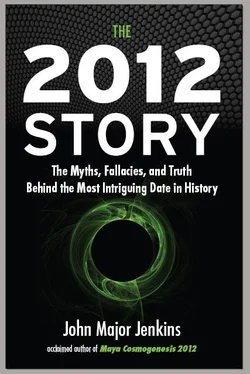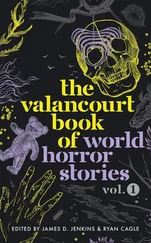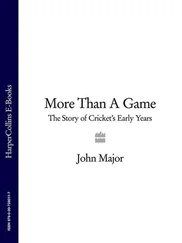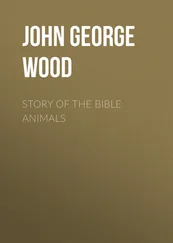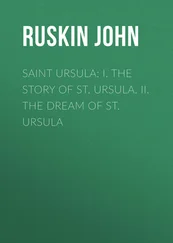New Year’s Day in Maya calendars.New Year’s Day is the first day of the haab. Since different cultural groups followed different haab placements, New Year’s Day occurs at different times for different groups. Also, since leap year was not recognized in the Maya haab, New Year’s Day precesses backward around the Gregorian calendar at the rate of one day every four years. This does not complicate the universally shared sacred count of 260 days.
Noetic, intellectus.The word “noetic” ultimately derives from the Greek word voŨς (nous), meaning “intellect, higher mind, thought.” It is associated with the direct knowing or intuition of noesis , involving a faculty of understanding superior to discursive, deductive reason.*
Nondual awareness.Awareness of the interdependence of subject and object. Non-dualism is a philosophy rooted in the direct experience that separateness is an illusion, and that the illusion of separateness is maintained only in more limited states of consciousness.*
North Celestial Pole.The center of the earth’s rotation projected into the northern sky. The stars appear to revolve around it. It sometimes corresponds to a star, but because the earth is slowly wobbling (see the precession of the equinoxes), it traces a circle in the northern skies very slowly over some 26,000 years.
One Hunaphu.The father of the Hero Twins in The Popol Vuh .
Ontology.The philosophical study of the nature of being, existence, or reality in general, as well as of the basic categories of being and their relations.
Pan-Mayanism.A term used by anthropologists Kay Warren and Victor Montejo, as early as 1997, to discuss and explain unifying political and cultural movements among the indigenous Maya of Mexico and Central America.
Pedagogue.One who is pedantic (see entry) in his or her style of writing or teaching. A person who evinces this style is pedagogical.
Pedantic.Describes a teacher or scholar who is characterized by a narrow concern for book learning and formal rules.
Perennial Philosophy.The notion of the universal recurrence of philosophical insight independent of epoch or culture, including universal truths on the nature of reality, humanity, or consciousness.* See also Primordial Tradition .
Performative contradiction.A lack of fit between the content and the performance (or sense) of the speech act. For example, “all statements must be false” creates a vicious circle. As pointed out by philosopher Ken Wilber, to assert that “there are no absolutes” is also a performative contradiction, revealing the inherent absurdity of one of modern deconstructionist philosophy’s most cherished premises.*
Photon Belt.A fringe idea that developed in the 1980s involving the belief in an energetic beam of light that sweeps through the galaxy, possibly emanating from the Galactic Center, or different density sectors of the galaxy that our solar system passes through during different eras. It has become loosely attached to 2012 and ideas involving contact with beings from the Pleiades. See also galactic synchronization .
Popol Vuh.A document recorded by Maya elders in the 1550s, possibly based on an older hieroglyphic book. It preserves within it a World Age doctrine, the story of the Hero Twins, as well as lineage titles and genealogies of Quiché Maya leaders. Some of the episodes preserved in The Popol Vuh are also found on Classic Maya vases and carved in stone at the pre-Classic site of Izapa.
Precession of the equinoxes.The earth spins once around its axis every twenty-four hours. The earth also exhibits a very slow wobble, changing its orientation in space such that the North Celestial Pole (see entry) traces a circle in the northern skies. One complete wobbles takes approximately 26,000 years. Precession affects the position of the sun on the solstices and equinoxes in relation to background features such as stars, constellations, and the Milky Way. The position of the sun on, for example, the March equinox precesses slowly backward along the ecliptic (see entry), moving into a different constellation every 2,160 years.
Pre-Classic Period.2500 BC to 200 AD. Its beginnings are marked by the development of the first ceramic traditions in Central and Western Mexico. Also known as the Formative Period, it is divided into three phases: the Early (2500-1200 BC), Middle (1500-600 BC), and Late (600 BC-200 AD).
Pre/trans fallacy.According to philosopher Ken Wilber, the nonrational stages of consciousness (what Wilber calls “prerational” and “transrational” stages) can be easily confused with one another. One can reduce supposed “transrational” spiritual realization to prerational regression, or one can elevate prerational states to the transrational domain. For example, Wilber claims that Freud and Jung commit this fallacy. Freud considered mystical realizations to be a fallacy of reduction. Wilber thinks that Jung commits the converse form of the same mistake by considering prerational myths to reflect divine realizations. Likewise, prerational states may be misidentified as postrational states. Wilber characterizes himself as having fallen victim to the pre/trans fallacy in his early work.* See http://wilber.shambhala.com/html/books/cowokev1_intro.cfm.
Primordial Tradition.A school of religious philosophy that holds its origins in the philosophia perennis et universalis , or Perennial Philosophy, which is in turn a development of the prisca theologia of the Middle Ages. The early exponents in the early-twentieth-century revival of this view of reality include Ananda Coomaraswamy, René Guénon, and Aldous Huxley. The Primordial Tradition seeks to establish a fundamental substratum of religious belief in all authentic religious teachings, adhering to the principle that universal truths are a cross-cultural phenomenon and transcendent of their respective Traditions, mythologies, and religious beliefs. The idea of the Primordial Tradition was well received by both practitioners and the academic community, and its development was actively endorsed by the International Conference of Religions in Chicago, 1893. The Primordial Tradition does not elevate any Tradition or religion above another, and instead upholds the truth claims of all authentic religions and spiritual movements. Adherents of the Primordial Tradition can be found in any religious system, such as Hinduism, Buddhism, Paganism, Christianity, or Islam.* The Maya and other New World indigenous civilizations have been excluded from belonging to the Primordial Tradition, a situation that is no longer tenable. See also Perennial Philosophy .
Quetzalcoatl.A Nahuatl deity that is the same as the Maya Kukulcan. Also called the Plumed Serpent, this deity embodies the principle of uniting opposites and transcending duality. In some teachings, a “quetzalcoatl” is an enlightened person who has integrated the dual cosmic forces within his or her own being.
Sacred Calendar. Although this term usually refers to the 260-day cycle by itself, it can also refer to the complete framework of time cycles used by the Maya.
Sacred cycle.Refers to the 260-day cycle (the tzolkin).
Sacred Day of Venus.The sacred day (including its number coefficient) that begins a Venus Round. Example: 1 Ahau is the traditional Sacred Day of Venus. Ahau, by itself, is simply the Senior Sacred Day (coefficient is required to designate the Sacred Day apart from any occurrence of Ahau).
Читать дальше
